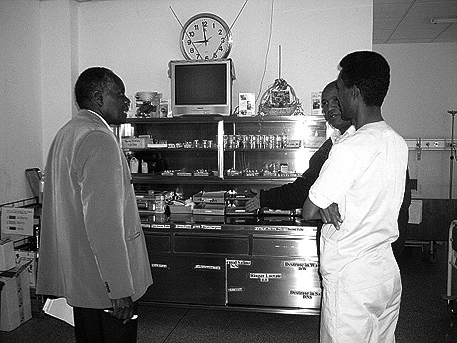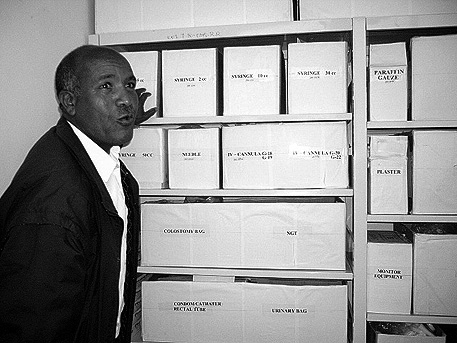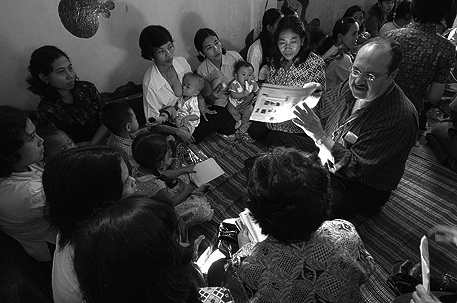Japan's Official Development Assistance White Paper 2009
(2) Health, Welfare, and Population
A large number of people living in developing countries cannot access basic health services that are usually available in developed countries. As immunization and sanitation have not been set in place, more than 25,000 children under five years old die every day due to causes such as infectious diseases, nutritional disorders, and diarrhea (Note 12). Moreover, more than 500,000 pregnant women lose their lives every year due to the lack of emergency obstetric care by skilled birth attendants like midwives.
Conversely, in line with its continuing steady rise, the world's population is expected to reach 9.2 billion people by 2050 (Note 13). In general, among the developing countries there continues to be a tendency for poor countries to have a higher population growth rate, which leads to poverty, unemployment, food shortages, underdeveloped education, and environmental deterioration. From this perspective, maternal, newborn and child health care reproductive health (Note 14) including family planning and HIV/AIDS control, which can have an enormous impact on population issues, have become pressing challenges.
Notes:
(12) Source: WHO, World Health Statistics, 2008.
(13) Source: UNFPA, 2008 State of World Population, 2008.
(14) Reproductive health is a state of complete physical, mental and social well-being, and not merely the absence of reproductive disease or infirmity. Reproductive health deals with the reproductive processes, functions and system at all stages of life.
<Japan's Efforts>
At the G8 Kyushu Okinawa Summit in 2000, Japan took up the issue of infectious diseases as one of its main themes for the first time in the history of the summit meetings. In 2005 Japan formulated the Health and Development Initiative (HDI), which aims to contribute to the achievement of the health-related Millennium Development Goals (MDGs). Under HDI, Japan takes a comprehensive approach that includes fighting against infectious diseases, maternal, newborn and child health care, and strengthening health systems. It also provides support that takes into consideration coordination with sectors that are closely related to health, such as water and sanitation and also basic education. Moreover, Japan takes initiatives through the Global Fund to Fight AIDS, Tuberculosis and Malaria (the Global Fund) in order to tackle HIV/AIDS, tuberculosis, and malaria. As of March 2009, Japan has contributed about US$1.04 billion to the Global Fund.
•See page 56 for details on infectious disease countermeasures.
Regarding maternal and child health, Japan supports the fostering of healthcare professionals working on the front lines, improves and provides equipment for obstetrics facilities, and carries out initiatives related to improving the quality of emergency obstetric care in order to improve the health of women during pregnancy or labor. It also works to improve access to medical institutions by developing infrastructure, disseminate Maternal and Child Health (MCH) Handbooks which incorporate the perspective of continuum of care, disseminate medical checkups for women during pregnancy and labor and support their health management, and reduce child mortality and morbidity. Regarding family planning, Japan provides support for efforts like educational activities and the distribution of contraceptives for preventing unwanted pregnancies and premature births, focusing on education for adolescents in particular. In terms of specific initiatives, Japan provided community education to prevent infectious diseases from unsanitary water, childbirth and postpartum care designed to reduce the mortality rate of women during pregnancy and labor and newborns, and support for reproductive health education such as family planning. These initiatives were carried out through the United Nations Population Fund (UNFPA) from March to November 2008, and targeted approximately 82,000 women in Ethiopia.
At the G8 Hokkaido Toyako Summit in July 2008, Japan raised the importance of this comprehensive approach and forged consensus among the G8. It also announced the Toyako Framework for Action on Global Health (Note 15) by the G8 health experts. Japan also gave traction to international discussions in the health sector, such as holding an international conference on the three major communicable diseases in May 2008 and an international conference on strengthening health systems in November through public-private cooperation (Note 16). In January 2009, experts in Japan formulated recommendations for strengthening health systems (Note 17), on which Japan has been working together with domestic and foreign stakeholders.
Since 2002, Japan has been coordinating with the United States Agency for International Development (USAID) under the USAID-Japan Partnership for Global Health. Based on the results of the G8 Hokkaido Toyako Summit, Japan formulated a new action plan in June 2009, and has been working to promote more effective and efficient assistance.
Notes:
(15) This document is a proposal to G8 leaders from the G8 health experts. It was hailed in the outcome document of the G8 Hokkaido Toyako Summit.
(16) The International Symposium--From Okinawa to Toyako: Dealing with Communicable Diseases as Global Human Security Threats was held in Tokyo from May 23 to 24, 2008 through joint sponsorship. In addition, the International Conference on Global Action for Health System Strengthening was held in Tokyo from November 3 to 4, 2008 as a follow-up to the G8 Hokkaido Toyako Summit.
(17) Based on the aforementioned international conferences, the Working Group on Challenges in Global Health and Japan’s Contributions organized an international taskforce and compiled the G8 Hokkaido Toyako Summit Follow-Up--Global Action for Health System Strengthening: Policy Recommendations to the G8. The report gave specific recommendations concerning health human resources, health financing, and health information.
Clean Hospitals Program in 15 African Countries
The "5S" (Seiri meaning organize, Seiton meaning arrange, Seisou meaning clean up, Seiketsu meaning neat, and Shitsuke/Shukanka meaning discipline) is a quality control technique that was developed in Japan's manufacturing industry and used in medical settings. Japan has begun to support representatives of health administration and hospitals in 15 African countries to acquire this technique through training, and to improve work environments through the participation of all staff members at hospitals that serve as models in each country. Initiatives through the "5S" are well received because they allow workers to improve the work environment around them through their own creative ingenuity, as well as the medical services provided to people. For example, in Tanzania this initially started at one hospital, but at present it has expanded to hospitals in ten locations.


Photo: JICA
Project for Regional Health Planning to Improve Maternal and Child Health under Decentralization (Third Country Training in Indonesia)
The health of women during pregnancy had become a significant challenge in Indonesia. Trainees who had learned about the MCH Handbook activities and had returned home to Indonesia took the lead in developing an Indonesian language version of the MCH Handbook. A trial run was undertaken in 1994 with the cooperation of the Japanese government, and it was formally acknowledged as a national institution in 2004. At present, these have come to be used by many pregnant women and children in all 33 provinces around the country. Currently, Japan and Indonesia have begun an initiative to share its experiences in disseminating MCH Handbooks via training for the people of countries and regions which are considering introducing MCH Handbooks in the future. To date, trainees from places like Afghanistan and the Palestinian territories have taken part in this.

Photo: Kenshiro Imamura/JICA
